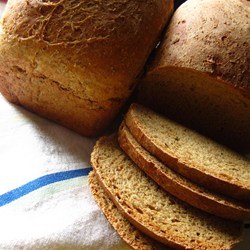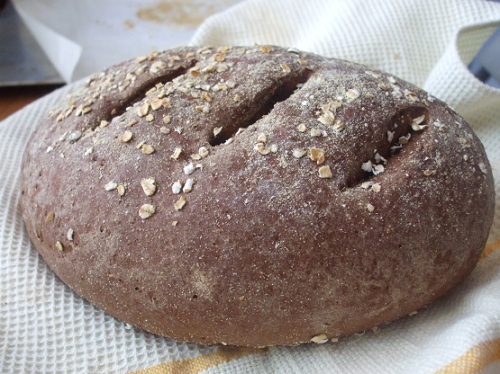Although the most common bread products are those which are made from wheat, bread made from whole rye is not to be ignored. Rye bread is dense in nutrients and vitamins, as well as being rich in fiber and protein.
Is Rye Bread Good for You?
Yes, rye bread is very healthy food. Rye is a cereal grain that is full of nutrients, such as calcium, iron, zinc and potassium. Much like wheat, whole grain rye is healthier than its refined counterpart. Although the refining process is more difficult with rye than it is with wheat, more nutrients remain in refined rye flour than they do in refined wheat flour. This means that rye bread not only has a hearty, rich taste, but is also the healthier option.
But what you need to know is that rye bread still contains gluten, so it should be avoided by those with celiac disease or gluten intolerance.
Below are the nutrition facts for one thin slice of rye bread (25 g). The percent daily values are based on a 2000 calorie diet.
|
Total Fat |
0.8 g |
1 % |
|
Sodium |
151 mg |
6 % |
|
Total Carbohydrate |
12 g |
4 % |
|
Dietary Fiber |
1.4 g |
5 % |
|
Protein |
2.1 g |
4 % |
|
Sugars |
1 g |
|
|
Magnesium |
2 % |
|
|
Calcium |
1 % |
|
|
Iron |
3 % |
|
|
Calories |
65 |
|
Why Is Rye Bread Good for You?
1. Regulate Bowel Movement
Insoluble fiber is predominant in rye bread. This type of fiber cannot be broken down by your digestive system and remains in your bowels. While being there, it absorbs water and helps to increase the amount of stool you produce, as well as prevents the stool from becoming too hard. This helps to promote regular and efficient bowel movements, as well as help to prevent constipation.
2. Lower Cholesterol Absorption
Whole-grain rye bread contains a higher level of dietary soluble fiber than bread made from wheat. Soluble fiber is dissolved in your intestines where it combines and binds with bile that contains cholesterol. Fiber and bile are excreted in your stool, meaning less cholesterol is absorbed in your intestines.
3. Reduce Diabetes Risk
Studies have shown that the consumption of grain fiber can significantly help in reducing your risk of developing type 2 diabetes. Whole grain rye bread is an excellent source of dietary fiber, both soluble and insoluble.
4. Control Blood Sugar
Rye bread has a low to medium glycemic index, which means that they have a lesser chance of increasing your blood sugar level. White bread has a higher glycemic index than rye bread and the consumption of the former often spikes your blood sugar levels.
5. Help Loose Weight
As rye bread has a high fiber content, it helps to slow down the digestion of carbohydrates and sugars so that your feelings of hunger will remain satisfied for longer. This means that you will be less likely to snack between meals. Eating rye bread in the morning is a great way to start the day and can help to decrease hunger up until, and after lunchtime.
How to Select Rye Bread
Since you know the answer to “is rye bread good for you”, you may want to know how to select rye bread in the store. When selecting rye bread, it is important to remember that some brands use white flour instead of rye flour, meaning you aren’t attaining the full nutritional benefits associated with rye bread.
When buying rye bread, or any food for consumption, you should always read the label to see what’s contained within it. To ensure you are actually purchasing whole, hearty rye bread, there are a few things to look out for on the packaging. Look for names like “whole-grain rye” and check the ingredients list for things such as whole rye flour, rye flakes, rye meal and rye kernels.
Another ingredient to look out for when selecting the right rye bread is sourdough. Rye bread is traditionally made with sourdough, as apposed to yeast. This helps to lower the breads glycemic index, making it the healthier option as it will not spike your insulin or blood sugar levels.
Rye Bread Recipes
1. Danish Spiced Rye Bread
 A traditional, highly spiced Danish rye bread
A traditional, highly spiced Danish rye bread
Ingredients
1 cup milk
3 tablespoons butter
1/2 cup of light molasses
1/3 cup white sugar
1 tablespoon orange zest (grated)
1 tablespoon fennel seed
1 tablespoon anise seed
1 tablespoon caraway seed
1 tablespoon cardamom
1 teaspoon salt
2 (0.25 ounce) packages active dry yeast
¼ cup warm water (110 ºF / 45 ºC)
2 cups rye flour
5 cups all-purpose flour
3 tablespoons butter (melted)
Directions
1. Heat the milk in a saucepan until small bubbles begin to form. Remove the milk just before it reaches a boil. Stir in the salt, cardamom, caraway seed, anise seed, fennel seed, grated orange zest, sugar, molasses, butter and water. Leave the mixture to cool at room temperature for thirty minutes.
2. Using a bread maker, stir the yeast and warm water, then leave it to sit for five minutes. Add the cooled spice and milk mixture to the bread machine, along with all the flour, then turn the bread machine onto a dough cycle.
3. Prepare two 9 x 5 inch loaf pans by greasing them. Once the dough cycle is complete, remove the dough from the bread machine and divide it in half to create two loaves. Place each loaf into a pan and cover. Leave to rise for thirty minutes.
4. Place the loaves into a preheated oven at 375 ºF (190 ºC) and bake for thirty-five to forty-five minutes. Once cooked, brush them with melted butter. Ensure to cool before serving.
2. German Dark Rye Bread
 A tasty dark rye bread known as ‘marbled rye’
A tasty dark rye bread known as ‘marbled rye’
Ingredients
3 cups all-purpose flour
¼ cup unsweetened cocoa powder
2 ¼ ounce packets active dry yeast
1 tablespoon caraway seed
1 tablespoon salt
1/3 cup molasses
2 tablespoons butter
1 tablespoon sugar
3 ½ cups rye flour
Cooking oil
2 cups water
Directions
1. Mix caraway seed, yeast, cocoa, salt and all-purpose flour in a large bowl.
2. Heat 2 cups of water, molasses, sugar, butter, 2 tablespoons of oil and stir until warm (110– 115 ºF).
3. Combine both mixtures and beat slowly for 30 seconds in electric mixer, then for 3 minutes at high speed.
4. Stir in rye flour by hand and place the dough onto a floured surface, then knead until smooth.
5. Let the dough rest for 20 minutes whilst covered. Then, divide it in half and shape 2 oval loaves. Brush the loaves with cooking oil, slash the tops, and cover.
6. Allow it to rise until it doubles in size; then bake in preheated oven at 400 ºF for 25-30 minutes. Ensure to cool before serving.
